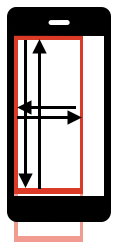Edit this Doc Simple Element swipe
Android: UIAutomator2
By default UIAutomator2 driver only returns elements, which are visible on the screen. If a container is split between the visible and invisible parts of the viewport then a part of its content won't be visible.

/**
* Performs swipe inside an element
*
* @param el the element to swipe
* @param dir the direction of swipe
* @version java-client: 7.3.0
**/
public void swipeElementAndroid(MobileElement el, Direction dir) {
System.out.println("swipeElementAndroid(): dir: '" + dir + "'"); // always log your actions
// Animation default time:
// - Android: 300 ms
// - iOS: 200 ms
// final value depends on your app and could be greater
final int ANIMATION_TIME = 200; // ms
final int PRESS_TIME = 200; // ms
int edgeBorder;
PointOption pointOptionStart, pointOptionEnd;
// init screen variables
Rectangle rect = el.getRect();
// sometimes it is needed to configure edgeBorders
// you can also improve borders to have vertical/horizontal
// or left/right/up/down border variables
edgeBorder = 0;
switch (dir) {
case DOWN: // from up to down
pointOptionStart = PointOption.point(rect.x + rect.width / 2,
rect.y + edgeBorder);
pointOptionEnd = PointOption.point(rect.x + rect.width / 2,
rect.y + rect.height - edgeBorder);
break;
case UP: // from down to up
pointOptionStart = PointOption.point(rect.x + rect.width / 2,
rect.y + rect.height - edgeBorder);
pointOptionEnd = PointOption.point(rect.x + rect.width / 2,
rect.y + edgeBorder);
break;
case LEFT: // from right to left
pointOptionStart = PointOption.point(rect.x + rect.width - edgeBorder,
rect.y + rect.height / 2);
pointOptionEnd = PointOption.point(rect.x + edgeBorder,
rect.y + rect.height / 2);
break;
case RIGHT: // from left to right
pointOptionStart = PointOption.point(rect.x + edgeBorder,
rect.y + rect.height / 2);
pointOptionEnd = PointOption.point(rect.x + rect.width - edgeBorder,
rect.y + rect.height / 2);
break;
default:
throw new IllegalArgumentException("swipeElementAndroid(): dir: '" + dir + "' NOT supported");
}
// execute swipe using TouchAction
try {
new TouchAction(driver)
.press(pointOptionStart)
// a bit more reliable when we add small wait
.waitAction(WaitOptions.waitOptions(Duration.ofMillis(PRESS_TIME)))
.moveTo(pointOptionEnd)
.release().perform();
} catch (Exception e) {
System.err.println("swipeElementAndroid(): TouchAction FAILED\n" + e.getMessage());
return;
}
// always allow swipe action to complete
try {
Thread.sleep(ANIMATION_TIME);
} catch (InterruptedException e) {
// ignore
}
}
iOS: XCUITest
XCUITest shows elements outside screen. It is strongly advised to use either screen swipe or 'mobile:scroll' / 'mobile:swipe' methods. If you still need or prefer to try element method you should consider the following: 1. Check that both start and end points are on screen. 2. Scrollview is often a background element. Any header/footer or other elements overlap it and limit swipe possibilities. Try to fix it by configuring correct borders. If borders differ per screen - make them configurable via swipe function variables.
/**
* Performs swipe inside an element
*
* @param el the element to swipe
* @param dir the direction of swipe
* @version java-client: 7.3.0
**/
public void swipeElementIOS(MobileElement el, Direction dir) {
System.out.println("swipeElementIOS(): dir: '" + dir + "'"); // always log your actions
// Animation default time:
// - Android: 300 ms
// - iOS: 200 ms
// final value depends on your app and could be greater
final int ANIMATION_TIME = 200; // ms
final int PRESS_TIME = 500; // ms
// init screen variables
Dimension dims = driver.manage().window().getSize();
Rectangle rect = el.getRect();
// check element overlaps screen
if (rect.x >= dims.width || rect.x + rect.width <= 0
|| rect.y >= dims.height || rect.y + rect.height <= 0) {
throw new IllegalArgumentException("swipeElementIOS(): Element outside screen");
}
// init borders per your app screen
// or make them configurable with function variables
int leftBorder, rightBorder, upBorder, downBorder;
leftBorder = 0;
rightBorder = 0;
upBorder = 0;
downBorder = 0;
// find rect that overlap screen
if (rect.x < 0) {
rect.width = rect.width + rect.x;
rect.x = 0;
}
if (rect.y < 0) {
rect.height = rect.height + rect.y;
rect.y = 0;
}
if (rect.width > dims.width)
rect.width = dims.width;
if (rect.height > dims.height)
rect.height = dims.height;
PointOption pointOptionStart, pointOptionEnd;
switch (dir) {
case DOWN: // from up to down
pointOptionStart = PointOption.point(rect.x + rect.width / 2,
rect.y + upBorder);
pointOptionEnd = PointOption.point(rect.x + rect.width / 2,
rect.y + rect.height - downBorder);
break;
case UP: // from down to up
pointOptionStart = PointOption.point(rect.x + rect.width / 2,
rect.y + rect.height - downBorder);
pointOptionEnd = PointOption.point(rect.x + rect.width / 2,
rect.y + upBorder);
break;
case LEFT: // from right to left
pointOptionStart = PointOption.point(rect.x + rect.width - rightBorder,
rect.y + rect.height / 2);
pointOptionEnd = PointOption.point(rect.x + leftBorder,
rect.y + rect.height / 2);
break;
case RIGHT: // from left to right
pointOptionStart = PointOption.point(rect.x + leftBorder,
rect.y + rect.height / 2);
pointOptionEnd = PointOption.point(rect.x + rect.width - rightBorder,
rect.y + rect.height / 2);
break;
default:
throw new IllegalArgumentException("swipeElementIOS(): dir: '" + dir + "' NOT supported");
}
// execute swipe using TouchAction
try {
new TouchAction(driver)
.press(pointOptionStart)
// a bit more reliable when we add small wait
.waitAction(WaitOptions.waitOptions(Duration.ofMillis(PRESS_TIME)))
.moveTo(pointOptionEnd)
.release().perform();
} catch (Exception e) {
System.err.println("swipeElementIOS(): TouchAction FAILED\n" + e.getMessage());
return;
}
// always allow swipe action to complete
try {
Thread.sleep(ANIMATION_TIME);
} catch (InterruptedException e) {
// ignore
}
}
